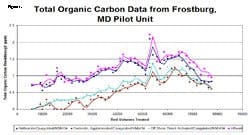Anthracite Vs. Granular Activated Carbon for Removing Disinfection By-Products
The city of Frostburg is a small municipality in western Maryland. The current water treatment plant treats a flow rate of 3 mgd to serve the city and surrounding communities. Until recently, the city had been using anthracite coal for physical filtration of its drinking water supply.
Due to the upcoming EPA regulations limiting the allowable discharge of disinfection by-products, the city had to consider making changes to its treatment process.
Making a Change
One option the city considered was to replace the existing anthracite filter media with granular activated carbon (GAC). To evaluate this alternative, Calgon Carbon Corp. provided pilot equipment to test the effectiveness of GAC in removing a variety of organics, including TTHMs (total trihalomethanes) and HAA5s (the group of five haloacetic acids).
While the main purpose of the pilot was to compare anthracite to GAC, the city also wanted to evaluate reagglomerated and direct activated carbons under identical treatment conditions. This was a way to ensure that the best activated carbon product was being selected for the application.
The pilot columns provided for treatment of a slipstream of 2.3 liters/min. (0.6 gpm) and a total contact time of 10 minutes through the media (gravel, sand, garnet, and anthracite or GAC). The contact time through the anthracite/GAC step was two minutes. Normal contact times for GAC in surface water treatment are typically 10 minutes, but since this pilot was studying the replacement of anthracite with GAC, equal volumes of GAC and anthracite were provided, with the lower contact time of the anthracite bed being held constant.
Water quality parameters measured were Total Organic Carbon (TOC), UV254 Absorbance, TTHMs, and HAA5s. The columns were allowed to treat nearly 80,000 bed volumes of water during the trial, for approximately 180 days.
Trial Results
- Both activated carbon products exceeded the performance of anthracite for all of the water quality parameters tested;
- The reagglomerated and direct activated carbons both exhibited similar breakthrough characteristics for TOC and UV254, with the reagglomerated GAC removing approximately 10% more total TOC and UV254 Absorbance over the life of the trial
(Figure 1 and Figure 2); - Both products effectively reduced the HAA5 levels to below 5 ppb throughout the trial; and
- The most dramatic difference in performance was with TTHM removal (Figure 3). The reagglomerated product treated double the water volume before reaching saturation for TTHM’s, and the direct activated GAC exhibited what is known as “rollover” - the desorption of TTHM (probably due to adsorption of other, more highly adsorbable species) that approached the limit of 80 ppb.
Based on the results of this trial, Frostburg decided to replace the anthracite with GAC. The product of choice specifically was domestically produced reagglomerated GAC. Considering the pilot results, the expected bed life of the GAC system is approximately 10 months before exchange of the carbon will be required.
